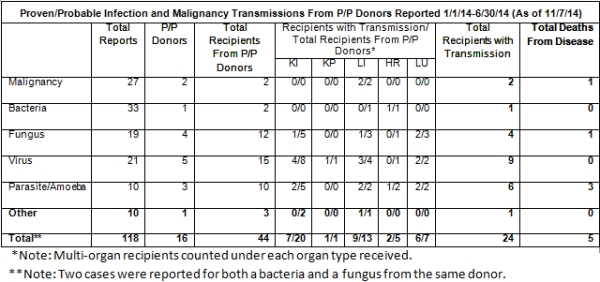Donor Derived Transmission Events in 2014: A Report of the OPTN Ad Hoc Disease Transmission Advisory Committee (DTAC)
1OPTN Ad Hoc Disease Transmission Advisory Committee, Richmond, VA
2United Network for Organ Sharing, Richmond, VA.
Meeting: 2015 American Transplant Congress
Abstract number: 21
Keywords: Donation, High-risk, Infection, Malignancy
Session Information
Session Name: Concurrent Session: Donor-Derived Infection/Lifestyle/Tourism/Vaccines
Session Type: Concurrent Session
Date: Sunday, May 3, 2015
Session Time: 2:15pm-3:45pm
 Presentation Time: 2:27pm-2:39pm
Presentation Time: 2:27pm-2:39pm
Location: Room 115- AB
Background: The OPTN DTAC, a multidisciplinary committee, evaluates potential donor derived transmission events (PDDTE), including infections (I) & malignancies (M), to assess for donor transmitted events.
Methods: Reports of unexpected PDDTE to OPTN from 1/1/14-6/30/14 were fully reviewed by DTAC. The remainder are still being evaluated. We utilized a standardized algorithm for classification for each donor (D) and classified each individual recipient (R) for reported donors.
Results: Evaluations of 118/235 reported PDDTE are complete. Of these, 16/118 reported D had proven/probable (P/P) transmission of I, M or other conditions to 24/382 total R. Four reports involved live donors (2 I, 2 M); one resulted in transmitted disease. 13/83 potential infection events were classified as P/P affecting 21 R, resulting in 4 deaths. Bacteria were most frequently reported (33) but only 1 R from 1 D experienced P/P transmission. HBV & HCV accounted for 15 reports; 9 R had P/P transmissions from 4 D. Parasites/amoeba accounted for 10 reports resulting in 6 P/P infected R from 3 D. 2/27 D reported with potential malignancy events were classified as P/P, with 2 affected R and 1 death. Ten additional non-I, non-M PDDTE were also reported; 1 resulting in P/P transmission. Overall, the 16 PDDTE P/P donor events resulted in P/P transmission to 24 R including 7 kidney, 9 liver, 1 kidney-pancreas, 2 heart & 6 lungs when accounting for multi-organ transplants.
Conclusions: The percent with P/P transmissions remains low with 16 donors (14% of reported cases), especially when compared with total number of annual transplants. Lung recipients of infected donors may be at higher risk for donor derived transmission events then other organs. Despite widespread adoption of NAT testing, an increased number of transmissions of viral hepatitis was noted. Unlike previous years, no deaths attributable to bacterial or viral pathogens were noted. Cumulative analysis of outcome of all R should enhance our ability to develop strategies to reduce adverse events related to PDDTE.

To cite this abstract in AMA style:
Kaul D, Covington S, Taranto S, Green M, Wolfe C. Donor Derived Transmission Events in 2014: A Report of the OPTN Ad Hoc Disease Transmission Advisory Committee (DTAC) [abstract]. Am J Transplant. 2015; 15 (suppl 3). https://atcmeetingabstracts.com/abstract/donor-derived-transmission-events-in-2014-a-report-of-the-optn-ad-hoc-disease-transmission-advisory-committee-dtac/. Accessed December 19, 2025.« Back to 2015 American Transplant Congress
